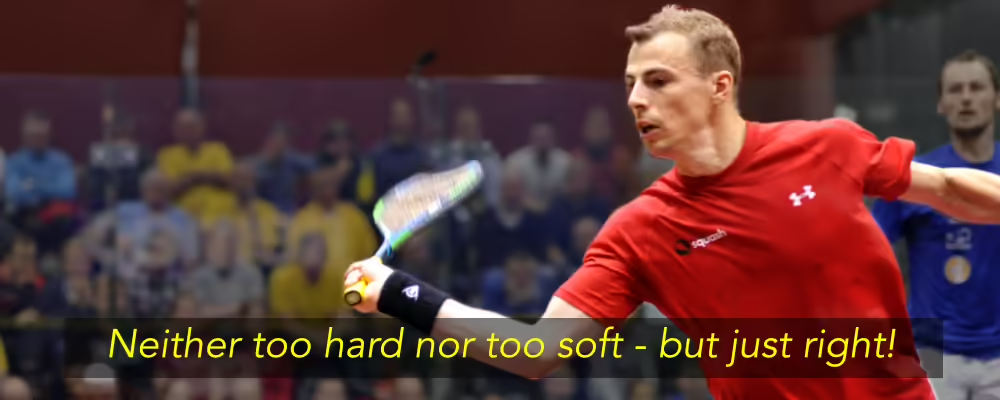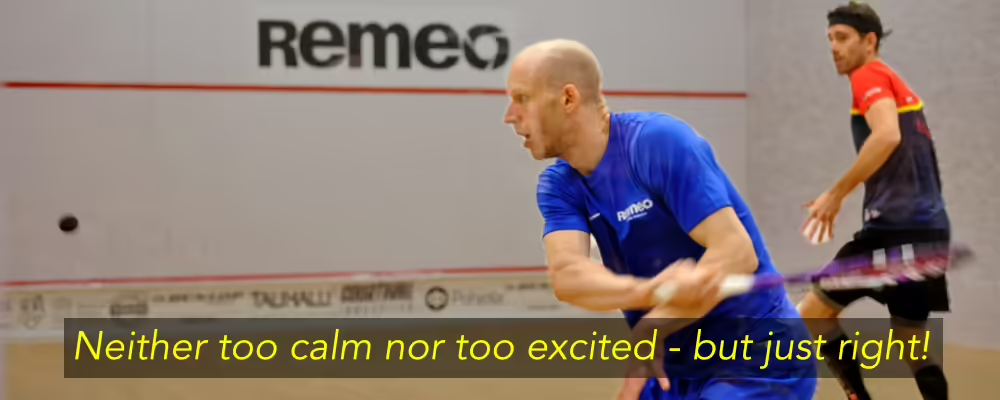04 January 2024 / 8-Min Read / Translate
I'm quite sure that you know the story of Goldilocks and the Three Bears (or at least you think you do!). I won't repeat it here, but I will tell you that originally it was 3 male bears who “fancy a home amongst the dwellings of men”. It wasn't a young girl who found their home but an old woman and they actually killed her - pretty different from the one we still tell today. Full, and I must say very interesting details can be found on this Toronto Library page.
Clearly it's all about the "not too hot nor too cold" and the "not too hard nor too soft" aspects that I am going to write about. But don't think it's simply about not hitting the ball too hard, it's far more provocative than that.

"Maximise", "Efficiency" and "Productivity" are trending words in today's society where it's all about getting the maximum benefit in the shortest amount of time. I'm certainly not against that but too often we mistake brevity for efficiency. And of course, nobody wants to waste their time. When it comes to training, the first thing you need to do is prioritise. Create a list, ideally with the help of a coach and/or trainer, that details things you need to do to improve.
Without a list, you will be tempted to do the things you like to do as opposed to the things you need to do. This is really important, and I can't stress this enough. Sometimes the difference between improving and not improving is not how much you train, but what you train.
In addition, people often believe that the more they train, the better. The problem is that when it comes to technical aspects like swing mechanics/skill acquisition that's not true at all. Practicing one shot for too long can actually have the opposite effect.
Key Point:
Selecting just the right aspects to work on is vital. If you are working hard on the wrong aspects, you are not working smart!
A key aspect to consider when thinking about the amount of training is the proportions. For example, spending too long on solo drilling and not much on condition games. Or more on fitness and less on skill. This can be for the reasons given in Type of Training, i.e. you enjoy them more, but also because you don't have a plan.
We all would love somebody to give us a personalised and realistic training plan, but the reality is that you often have to develop one yourself. Each player needs to find what works for them. For example, so people benefit from 2 solo sessions a week, whereas others only need 1. Some players require more time pairs drilling, whereas others require more match play.
What you need to do is experiment with different quantities and proportions of different types of training to see how you respond. I have made a video called Squash Tips: Squash Training Guidelines that explains things in a little more detail.
Key Point:
You need to find the right proportion of SKILLS TRAINING: solo drilling, pairs drilling, condition games, match play and coaching, and FITNESS TRAINING: Cardio, strength, flexibility, recovery, nutrition.
Geoff Hunt used to say that you should only hit 1 in 10 of the boasts you think about playing. Whether that is still true nowadays I don't know. What is true is that most amateur players hit way too many crosscourts and not enough lobs. There are good reasons for the first one (you are probably in the way of a straight drive), but very few for the second. So what has this got to do with Goldilocks Squash? Proportions - yes again. There's no golden ratio of proportions of shots and there never will be because there are too many variables to take into account when considering shot selection. What works for one opponent won't be the same for another opponent even if they are the same level and have the same playing style.
I'm not saying that there isn't a good guideline for shot selection proportions, I'm just saying it would be a very personal guide. The chances are though that just like training, you are probably playing the shots you enjoy more often than you should. I know it's easy for me to say "play the right shot not your favourite one" but that's what you need to do to win.
I often ask my pupils to identify their favourite shot then stop playing it for a month. The chances are you have become over-dependent on that shot and that month should allow you to develop other shots to win points from. What I am essentially asking you to do is probably play less crosscourts!
Key Point:
You need to play "just the right amount" of each type of shot. Each player would have very different proportions and could still be successful. I can tell you now, I play better squash with less crosscourts. What about you?

Today, I can hit the ball about 80% of my maximum of when I was 25 years old, but I can probably move under 50% as fast. Not only that, I can probably only hit at 80% for under a minute and then I am tired, whereas when I was younger, I could hit harder for longer. It's not unexpected: I'm old and you might be too. However, even if you are not old, you have to acknowledge and understand the relationship between your hitting speed and your moving speed.
At amateur level, most people hit harder than they should. They hit hard because they think they rush their opponent, but in reality they rush themselves. In the heat of battle, that can be difficult to recognise and a vicious cycle of hitting harder and harder in the hopes of winning points. It rarely happens.
At the other end of the scale, and I make no apologies for my harsh description, you have old men, say over 50 or 55, who try to hit sneaky drops shots and nicks after the rally has lasted for more than 3 shots. I hate that kind of squash. It's boring and turns into 2 shot rallies that nobody enjoys. However, those men are playing smart squash for their circumstances. They are acutely aware that they can't cover their own power shots so they don't try.
Key Point:
Ask yourself this, is the speed I am hitting the ball helping me win? If it's not, change it or at least vary it a little more. if you can't cover your opponents' returns when you hit the ball hard, that's not smart squash.
Arousal level in sports performance refers to the state of physiological and psychological readiness, impacting an athlete's energy, attention, and focus during an activity. So, if you are too calm and relaxed, you won't perform at your best, and if you are too aroused i.e. too anxious or your body is too stressed, you also won't perform at your best. This really is the Goldilocks of Sports Performance!
For those curious, it's often called the Yerkes-Dodson Law, which was originally developed in 1908 - so it's not new!
Honestly, "Arousal in Squash Performance" is a whole article in itself, but I'm not qualified to write it. However, for most amateurs playing competitive squash, finding the right level of arousal simply requires experience, which comes from playing lots of competitive matches, and trying various approaches.
My experiences are by no means valid for all players, but I found to play my best, I had to detach my emotions from the match and focus them on the opponent. I had to develop a dislike for them and a feeling of wanting to punish them. Again, let me stress that I am NOT suggesting this si a valid approach for everybody, just using it as an example.
Key Point:
We need to be aroused to play our best and finding the right level of that arousal is important, but just as important is the route to that level. Experiment with different approaches to see what suits you best.
The key point I want you to remember from this articles is that "more is NOT better". Finding the right balance between various aspects of your squash; skill versus fitness, hitting speed versus moving speed, straight versus crosscourt versus boast, and too calm versus too excited.
Daddy bear's porridge was perfect for him and mummy bear's bed was perfect for her. What's right for me might not be right for you.
Constantly be assessing your effort and focus, thoughtless hard work is not as productive as considered hard work.
As always, if you would like to share your thoughts with me about this article, please send me an email and we can talk.